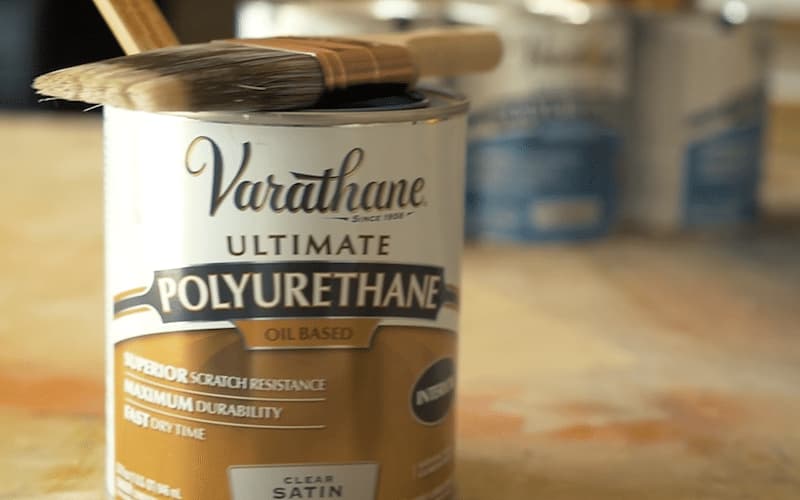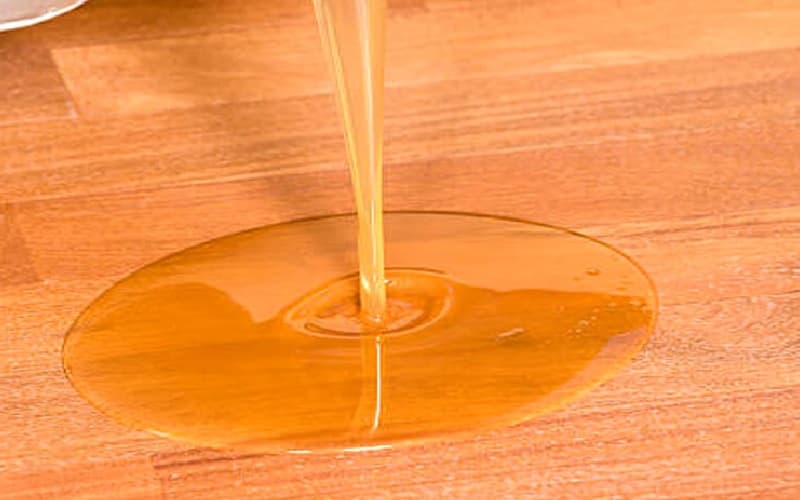Polyurethane paint has many advantages, including strong protection, versatility, durability, and aesthetics. It is a popular finishing paint for wood works and furniture. Knowing how to thin polyurethane will allow you to get better results.
You can thin water-based polyurethane with water or denatured alcohol. Oil-based varieties can be thinned with mineral spirits, turpentine, and paint thinner. The thinning ratio depends on the type of polyurethane and your desired level of consistency.
You mustn’t over-thin polyurethane to avoid making it too light for the application. I will cover the ideal thinning ratio in the following sections. I will also discuss the best ways to thin water-based and oil-based polyurethane paints.

Is it Okay to Thin Polyurethane?
It is perfectly okay to thin polyurethane. Paint enthusiasts would agree that thinning polyurethane eases the application process.
Thinning your polyurethane will give you more control over the paint. It allows you to apply thin layers to avoid the painted object or surface looking like plastic.
Some paint users choose not to thin water-based polyurethane because of its already-good consistency. However, if you wish to improve the ease of applying the paint, you can thin it with a small amount of water.
In most cases, paint users thin oil-based polyurethane because of its thicker consistency. Aside from making the application easy, thin paint can provide a more professional-looking result.
Other benefits of thinning your polyurethane include faster drying, a cleaner process (minimal chances of blotching), and a less tacky surface. Does thinning your paint speed up the job? I am not entirely confident that speeds up the whole process.
Applying multiple thin coats until you are satisfied with the result can take some time. Additionally, you need to pause after every layer to wait for the first layer to dry. So, technically, you are not saving time to complete your project earlier.
Best Ways to Thin Polyurethane
The thinning agent to use when thinning a polyurethane paint depends on the type of polyurethane you are working on. The paint and the thinner ratio should also be carefully measured to avoid cases of over-thinning.
Additionally, a proper stirring of the paint while thinning is also critical. Vigorously stirring or shaking the paint will destroy the paint’s texture. It can create air and bubbles that will give you ugly results.
1. Thinning Water-Based Polyurethane
You must thin water-based polyurethane with water. If you want to use an alternative thinning agent, you can use denatured alcohol.
Water as the Thinning Agent
Water is the default thinning agent for water-based polyurethane because it complements the paint’s original solvent. Of course, water mixes well with water.
Denatured Oil as the Thinning Agent
Denatured alcohol is an alternative to water. Some people use it over water. However, most woodworkers do not recommend its usage because of its strong smell and toxins.
The ideal ratio when thinning water-based paint is to add 10% water for the paint’s total amount. However, you can decide to go with 5% if you wish your paint to be only slightly thin.
What You Need to Thin Water-Based Polyurethane
Here are the things you need to thin water-based polyurethane:
- Protective suits (gloves, goggles, a mask)
- Water or denatured oil
- Clean stirrer
- Clean mixing jar or a plastic container
- Measuring cup
Steps to Thin Water-Based Polyurethane
The steps provided below can be generic. However, it should provide proper guidance as you start the thinning process.
Step 1: Wear your protective suits.
You must take the necessary precautions when exposing yourself to a paint formula. Although water-based paints are generally safe, they contain ingredients that may cause skin and eye irritations.
Moreover, the paint’s fume may cause adverse health effects such as dizziness and headache. Thus, you better be safe than sorry. Wear your hand gloves, goggles, and protective mask.
Step 2: Open the paint can to prepare it for thinning.
Carefully open the polyurethane can. You need to ensure that you don’t damage the container lid. This step is important for storing any excess paint after completing your project.
Step 3: Stir the paint solution.
Stirring the paint solution plays an important role. A paint solution is a mixture of different ingredients. Over time, these ingredients can separate, and you need to stir the mix to restore its original consistency.
To avoid creating air bubbles, stir the solution slowly using your paint stirrer, making an “8” figure motion. You must do this process for at least three minutes before moving on to the next step.
Step 4: Measure the paint and water and transfer them to the mixing jar.
This step is critical. You must know how many cups you have measured and poured into the mixing container. Failure to accurately measure or count the number of cups you poured into the jar may result in thinning failure.
After measuring the paint, get the 10% of the total amount of paint in the mixing container. Once you are done measuring, pour the water into the paint and proceed to the next step.
Step 5: Stir the paint solution again.
Doing the same manner of stirring, stir the paint and water mixture for about three minutes. Keep checking the paint’s consistency. You can stir for up to five minutes as necessary or until you see that the paint has been thinned completely.
Once the paint is thinned, you can start applying it to your surface. It is always best to do multiple layers to obtain a beautiful finish.
Thinning Oil-Based Polyurethane

It is general knowledge that water and oil do not mix. With this fact, it is understood that you cannot thin oil-based polyurethane with water. Instead, you will need to use petroleum-based paint thinners.
The common oil-compatible thinning agents for oil-based polyurethane are mineral spirits, turpentine, and paint thinner. What are their differences?
All of these solvents are indispensable thinning agents for oil-based paints. They may have different chemical compositions but work almost the same in thinning polyurethane.
Mineral Spirits
Mineral spirits are clear and clean petroleum distillates. This substance is a “go-to” product for oil-based paint thinning. You can also use mineral spirits to clean stains and varnishes.
Turpentine
Turpentine is another useful solvent derived from gum turpentine or pine wood resin distillation. It is widely used in the paint industry as an additive. This substance is very volatile.
Paint Thinner
A paint thinner could generally refer to any solvent that aids in thinning paint. The term is somewhat regarded as petroleum-based thinners. This type of solvent costs slightly lower than mineral spirits.
What You Need to Thin Water-Based Polyurethane
Here are the things you need to thin water-based polyurethane:
- Protective suits (gloves, goggles, a mask)
- Oil-compatible thinning agent (mineral spirits, turpentine, or paint thinner)
- Clean stirrer
- Clean mixing jar or a plastic container
- Measuring cup
Steps to Thin Oil-Based Polyurethane
The steps in thinning an oil-based polyurethane are somewhat similar to those in thinning a water-based polyurethane.
Step 1: Wear your protective suits.
Before starting your thinning project, put on your hand gloves, goggles, and mask. Always ensure your safety. Oil-based paints contain more harmful ingredients that may cause health issues.
Additionally, the solvents you use to thin your oil-based polyurethane contains harmful chemicals. Expose yourself less to the toxins of these chemicals by taking proper precautions.
Step 2: Remove the paint can’s cover and stir the paint.
You can use a flat screw to do this step. Perform this step carefully, so you don’t damage the lid of the can. It is important that the container’s cover still seals tightly for future storing purposes.
Gently stir the oil-based paint with your stirring ruler or stick. You can perform the same “8” figure motion for three to five minutes. This step ensures that the paint’s ingredients mix evenly before thinning.
Step 2: Measure the oil-based paint and the thinning agent.
Accurately measure your polyurethane with your measuring cup and pour it into your mixing container. Similarly, measure the thinning agent of your choice and pour the substance into the same container.
You can either do a 1:1 or a 2:1 ratio. Do the latter if you wish to only slightly thin your paint. Remember, any ratio works as long as you do not over-thin the paint.
Those who have tried thinning polyurethane recommend adding the thinner gradually for better thinning. It may be the best technique if you are trying to thin a good amount of paint.
Step 3: Mix the paint and the thinner by stirring.
Stir the paint solution again to mix it with the thinning agent thoroughly. It is critical not to create bubbles in the paint mixture. Therefore, you need to do the stirring slowly.
Constantly check the paint’s consistency. You can stop stirring when the paint and the thinner completely mix or when you see that the solution has attained a uniform texture. You will achieve the thinned oil-based polyurethane in at most five minutes of stirring.
Should You Thin Polyurethane When Spraying?
Applying polyurethane using a sprayer is arguably the best method because of its characteristics. Applying your polyurethane with a paintbrush can be very challenging. Spraying the paint is the better option to achieve a professional-looking result.
Thinning the polyurethane paint before spraying may not be necessary if it is water-based. You can test-spray the paint without thinning and see if it gives you a good result. If the paint clots on the surface, it is an indication that you need to thin the paint solution.
Those who have used water-based polyurethane on spray guns recommend thinning it before you load it into your spray gun. They say that doing it gives them a more consistent mixture. As a result, they achieve an even and beautiful surface.
If you use the oil-based variety of polyurethane, you would likely need to thin the paint. The oil-based type of polyurethane has a thicker consistency than the water-based one.
Which is the better polyurethane to use with sprayers? Is it water-based or oil-based? The answer is: it depends on your preference. Both variants work with spray guns. It is the characteristics of the paint and the resulting product that you need to consider.
Water-based polyurethanes are generally safer to use. They contain fewer harmful ingredients. They are also less volatile compared to the oil-based variant.
However, water-based polyurethane is more difficult to apply than its oil-based counterpart. Although it dries up quicker, it does not produce a beautiful glow like oil-based paint.
Oil-based polyurethane may provide you with a better finish. However, because it contains more harmful chemicals, you need to take extra precautions not to expose yourself too much to the paint’s fumes.
FAQs
Water-based polyurethane is best thinned with water. You have many options when thinning oil-based polyurethane, including mineral spirits, turpentine, and paint thinners. Most woodworkers prefer mineral spirits.
You must not stir the paint and the thinner mixture vigorously. Doing this will create bubbles in the paint that could affect the overall result. Instead, gently stir the solution emulating a figure “8” shape. The stirring duration could take between three to five minutes.
As a general rule, you do not thin oil-based paints with water. The reason is that water and oil are not chemically compatible. Please do not attempt to do it so you will not destroy your polyurethane. Use mineral spirits, turpentine, or any petroleum-based paint thinners.
Conclusion
You can thin water-based polyurethane with water or denatured oil. To do it, add 5 or 10% water to the paint’s total amount and gently stir the solution for three to five minutes. It is best to gradually add the solvent to the paint to achieve a better thinning result.
Oil-based polyurethane can be thinned using mineral spirits, turpentine, or paint thinner. The stirring is the same as with thinning the water-based polyurethane. You can gently stir the solution emulating a number “8” movement until you obtain a uniform texture.
